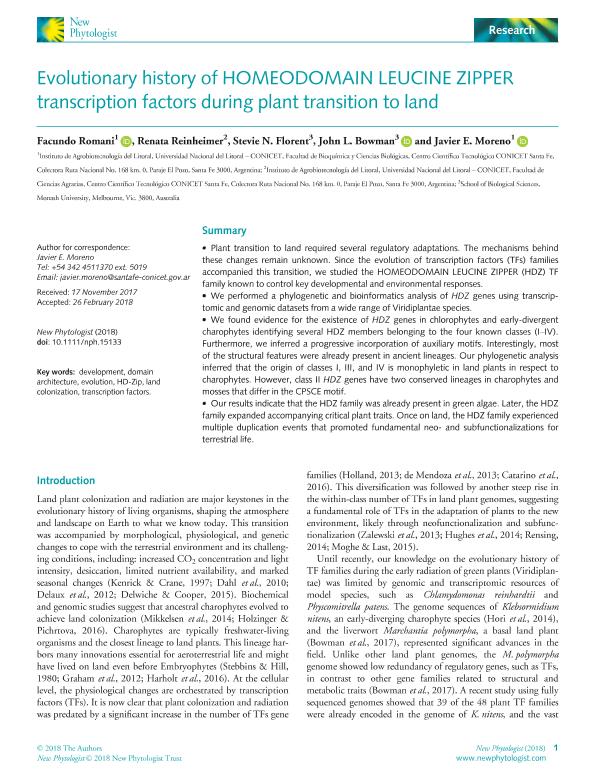Mostrar el registro sencillo del ítem
dc.contributor.author
Romani, Facundo Alihuen

dc.contributor.author
Reinheimer, Renata

dc.contributor.author
Florent, Stevie N.
dc.contributor.author
Bowman, John L.
dc.contributor.author
Moreno, Javier Edgardo

dc.date.available
2019-10-19T14:15:28Z
dc.date.issued
2018-07
dc.identifier.citation
Romani, Facundo Alihuen; Reinheimer, Renata; Florent, Stevie N.; Bowman, John L.; Moreno, Javier Edgardo; Evolutionary history of HOMEODOMAIN LEUCINE ZIPPER transcription factors during plant transition to land; Wiley Blackwell Publishing, Inc; New Phytologist; 219; 1; 7-2018; 408-421
dc.identifier.issn
0028-646X
dc.identifier.uri
http://hdl.handle.net/11336/86531
dc.description.abstract
Plant transition to land required several regulatory adaptations. The mechanisms behind these changes remain unknown. Since the evolution of transcription factors (TFs) families accompanied this transition, we studied the HOMEODOMAIN LEUCINE ZIPPER (HDZ) TF family known to control key developmental and environmental responses. We performed a phylogenetic and bioinformatics analysis of HDZ genes using transcriptomic and genomic datasets from a wide range of Viridiplantae species. We found evidence for the existence of HDZ genes in chlorophytes and early-divergent charophytes identifying several HDZ members belonging to the four known classes (I–IV). Furthermore, we inferred a progressive incorporation of auxiliary motifs. Interestingly, most of the structural features were already present in ancient lineages. Our phylogenetic analysis inferred that the origin of classes I, III, and IV is monophyletic in land plants in respect to charophytes. However, class IIHDZ genes have two conserved lineages in charophytes and mosses that differ in the CPSCE motif. Our results indicate that the HDZ family was already present in green algae. Later, the HDZ family expanded accompanying critical plant traits. Once on land, the HDZ family experienced multiple duplication events that promoted fundamental neo- and subfunctionalizations for terrestrial life.
dc.format
application/pdf
dc.language.iso
eng
dc.publisher
Wiley Blackwell Publishing, Inc

dc.rights
info:eu-repo/semantics/openAccess
dc.rights.uri
https://creativecommons.org/licenses/by-nc-sa/2.5/ar/
dc.subject
DEVELOPMENT
dc.subject
DOMAIN ARCHITECTURE
dc.subject
EVOLUTION
dc.subject
HD-ZIP
dc.subject
LAND COLONIZATION
dc.subject
TRANSCRIPTION FACTORS
dc.subject.classification
Ciencias de las Plantas, Botánica

dc.subject.classification
Ciencias Biológicas

dc.subject.classification
CIENCIAS NATURALES Y EXACTAS

dc.title
Evolutionary history of HOMEODOMAIN LEUCINE ZIPPER transcription factors during plant transition to land
dc.type
info:eu-repo/semantics/article
dc.type
info:ar-repo/semantics/artículo
dc.type
info:eu-repo/semantics/publishedVersion
dc.date.updated
2019-10-18T18:37:23Z
dc.journal.volume
219
dc.journal.number
1
dc.journal.pagination
408-421
dc.journal.pais
Reino Unido

dc.journal.ciudad
Londres
dc.description.fil
Fil: Romani, Facundo Alihuen. Instituto de Agrobiotecnología del Litoral (conicet-unl); Argentina
dc.description.fil
Fil: Reinheimer, Renata. Instituto de Agrobiotecnología del Litoral (conicet-unl); Argentina
dc.description.fil
Fil: Florent, Stevie N.. Monash University; Australia
dc.description.fil
Fil: Bowman, John L.. Monash University; Australia
dc.description.fil
Fil: Moreno, Javier Edgardo. Instituto de Agrobiotecnología del Litoral (conicet-unl); Argentina
dc.journal.title
New Phytologist

dc.relation.alternativeid
info:eu-repo/semantics/altIdentifier/doi/http://dx.doi.org/10.1111/nph.15133
Archivos asociados
